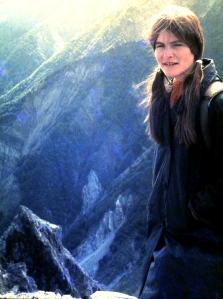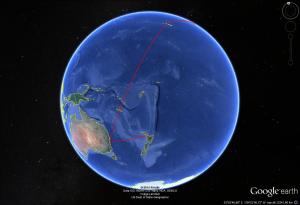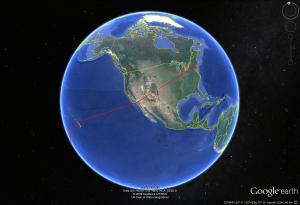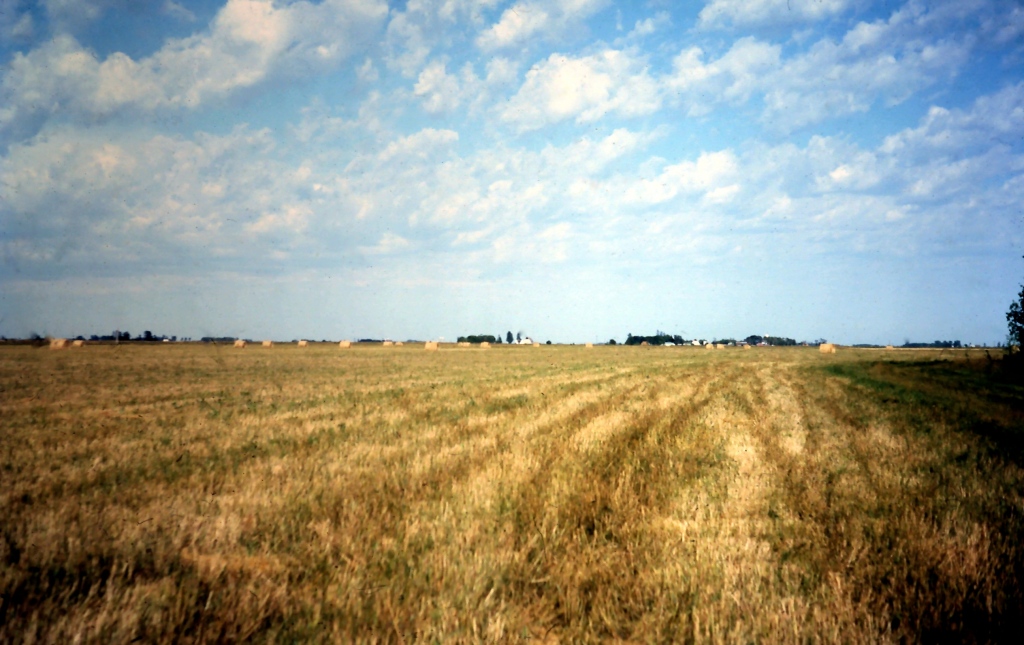“The beauty of travel, as of love or terror, is that it regularly turns all your ideas on your head and reminds you that you really know nothing at all.” Pico Iyer

Near top of “Three Johns” in central Ruahines, NZ, looking NW over the head of the Waipawa River – April 1973
I’m used to a land crunched up on itself. The force of two tectonic plates grinding together makes for a lot of earthquakes and dramatic scenery. And in 1975 my playground was the back country and the mountains of North Island, NZ. It’s a rugged, wild place which can and does break the minds, hearts and bodies of the ill-prepared and the unlucky. And yet, the deep green of ponga (tree ferns) against the bluest of blue skies, the dawn chorus in summer, even a wintry southerly sharp with the smell of the Antarctic are a salve for the soul – my soul.
I left all that behind when I set off on my student exchange year. I was headed to the Red River Valley, in heartland USA. Although I had looked on a map I had no way of visualising the landscape.
Getting there involved a written application, a local AFS (American Field Service student exchange progamme) Branch panel interview, approval by AFS New Zealand, matching with a host family, months of preparation, orientation in Auckland, a prolonged bunny hop across the Pacific Ocean and continental USA (commercial airline flight to and from New Zealand was still relatively new, up until the 1960s most people arrived and left by boat), more orientation at CW Post College on Long Island, and then a two-day bus trip to heartland America.
The physical journey: 15/07/75 – 22/07/75
- Napier to Auckland: car (Dad’s Fairlane) 215 miles
- Auckland to Sydney: Air New Zealand, 1,339 miles
- Sydney to Honolulu, LA, New York: United Airlines, 9,925 miles
- New York – Chicago – Minneapolis – Fargo: GreyHound Bus, 1,442 miles
- Fargo to Breckenridge, MN: car (Host Dad’s Buick) 46 miles
Some of the mementoes from those six days that have survived, by chance only, the return trip to NZ, eight house shifts, and occasional bouts of decluttering:
- The airline menu of the Auckland to Sydney flight. They served a brunch of seasonal fresh fruit steeped in Maraschino liqueur, a mixed grill, and Moka Gateau (sic). Of all the odds and ends I’ve kept this one makes me laugh the most. Eating a fancy meal on a plane was a big deal at the time. Now, airline food is something to grumble about.
- My customs declaration for Sydney airport which tells big fat lies! I come from small town New Zealand. Of course I’d been on a farm during the previous three months – I just didn’t rate small holdings. To me real farms were sheep stations, like Erewhon or Lochinver.
- The welcome note to CW Post College, Long Island. My room was in Suffolk Hall. I can still picture it and I still remember the jet lag. We had a couple of days orientation on the campus. I can recall nothing about the actual orientation. What I do remember: the trauma of communal living – I’ve always liked my privacy; a talent show in the evening – the Kiwis performed a haka; and watching a bride in a white crinoline dress, not unlike Princess Di’s but minus the ruffles, arrive at the campus church.
- Instructions from AFS about who to phone if I got lost. There was never any real chance of that. We had chaperons almost all the way. My host family were waiting for me – arms wide in welcome – at the bus terminal in Fargo. (I did get lost once about six months later but that story is worth a post of its own.)
- A telegram, remember those? And my bus ticket for the Minneapolis – Fargo leg of the journey.
On the last leg of this zigzag journey from the Twin Cities, past St Cloud, north west to the border of Minnesota and North Dakota, the prairie flattened out ahead of me. I could not make sense of what I was seeing. I was headed towards a valley. Surely, I thought, I would see it soon.
12,967 miles from home, after almost a full week of travel I discovered this is what a valley looks like.
The Red River Valley was created by forces of nature as great as the earthquakes that shape New Zealand. It’s a huge glacial valley spanning Minnesota, North Dakota, and Manitoba. It’s drained by the Red River, which runs from south to north, a geological phenomenon that can cause problems in the thaw. It’s fertile farming country.
When we said goodbye, my grandfather, a fiercely proud man who never left New Zealand, instructed me: “You tell those Americans that New Zealanders are the best farmers in the world.” Sitting in the back of my host family’s car, on our way to my new home town, at the end of a week of travel and at the beginning of our year together, looking out at paddocks of wheat, sugar-beet, and sunflowers, I didn’t fancy my chances of being able to convince anyone of my granddad’s point of view.
Categories: AFS, Off-shore Adventures








Hi there nice post. What is AFS?
LikeLike
Hi there and thanks! AFS or American Field Service is an international student exchange programme.
LikeLike
Very interesting. Please repost in coveyview. It’s just what we need.
LikeLike
Thanks Meredith.
LikeLike
You are such a great story-teller Jill. I can almost picture myself gazing those great NZ mountains, while listening all-ears to your stories. Thank you for sharing!
LikeLike
So pleased you enjoyed it, Vasilis!
LikeLike
Great memories. Thanks for the tour!
LikeLike
🙂 Thanks Sue.
LikeLike
I too am finding this interesting reading. As flat as this area is, there are hills where the great continental divide runs and you can easily tell when you are entering it and leaving it. It doesn’t compare to any mountains you might see, but it can be hilly and some of the scenery along it is very pretty. I didn’t realize how much you had to go through to get here. Really tells me I lead a sheltered life. Looking forward to your next post.
LikeLike
Thanks so much, Mary! From memory, it starts to get hilly around Fergus Falls – is that correct? Over time I learned to read the landscape, and was able to tell where the valley began. But that wasn’t the case the day I arrived. I could only look at it with my Kiwi eyes which were used to a very different sort of valley. I think the whole area is majestic and dramatic and awe-inspiring. When I went back with my husband in 2006 we stopped the car several times to look and look, and look some more – trying to take it all in. He’s travelled widely, through Europe, Africa, and Asia, and had never seen anything like the Great Plains.
LikeLike
I grew up on these high plains, only further south at the edge of Nebraska and Kansas. The High Plains was home to Native peoples – one tribe’s land bordered our farm to the north. That connection, along with the sky, is why one of my names for myself is see-far woman. . I’ve never needed glasses for distances, only for those pieces of life so near my nose that they drive me a little crazy without glasses between me and them. But sky? Here’s an opening line from one of my poems: All of my life I’ve measured sky by Kansas sky.
I must admit, however, I’d love to see NZ. It’s majestic in an up and down way while the Plains are majestic in a horizon to horizon way.
LikeLike
I can get a sense of that horizon to horizon majesty when I look out at the Pacific. But it’s not quite the same because the hills, although behind me, are not so far away.
You opening line goes to the heart of my experience arriving in the Red River Valley. Thank-you for sharing it.
LikeLike
I am enjoying reading about this adventure. Having spent my entire life living in the US, I can tell you that the first time you see the expansive heartland of this country (or Canada’s version) it takes some getting used to. I visit family in Iowa (they moved there, not where we grew up) and I am always amazed at the scale, precision and speed of farming out there. I’ve driven across the US and Canada and I shutter to think about the portion of your journey spent on that bus. Perhaps the excitement carried the day, but I’m guessing that you were pretty happy to slip into that Buick for those final 46 miles.
LikeLike
Thanks, Dan. You are so right, The Great Plains take some getting used to – and once used to them, I think they’re in your blood for good. It was, indeed, a relief to finally arrive.
LikeLike